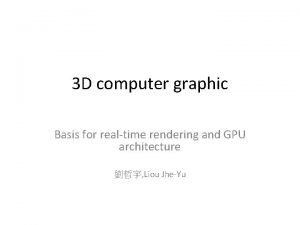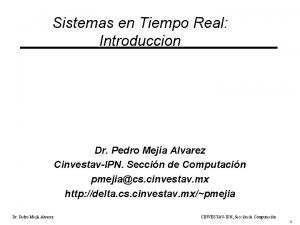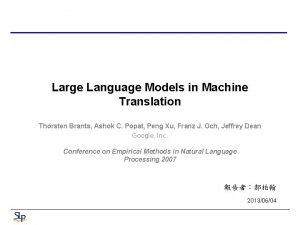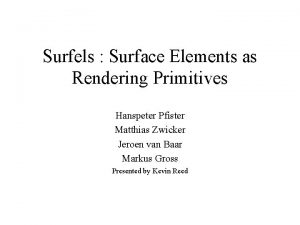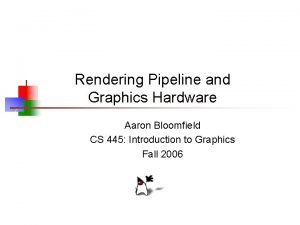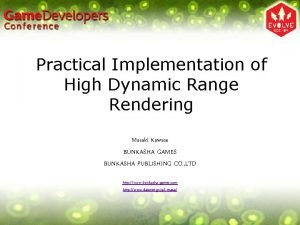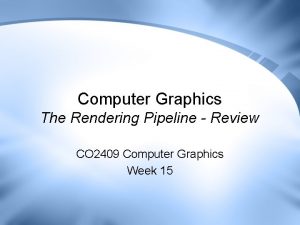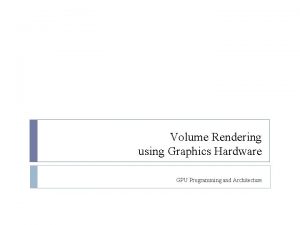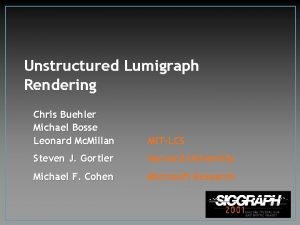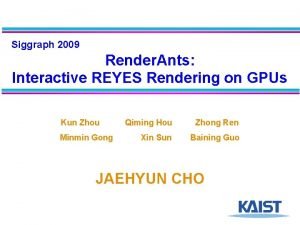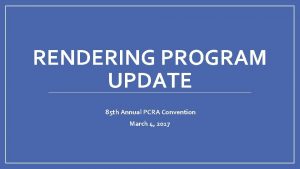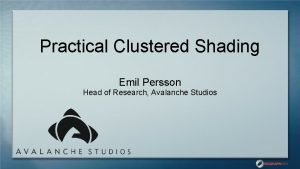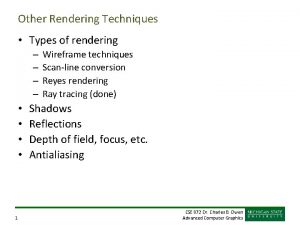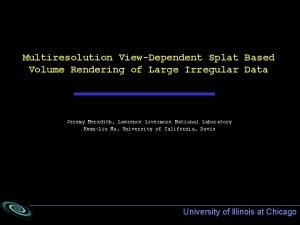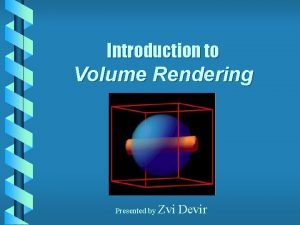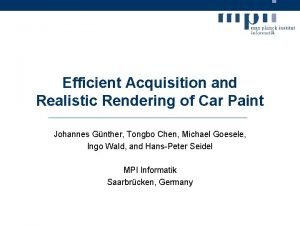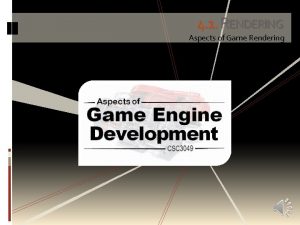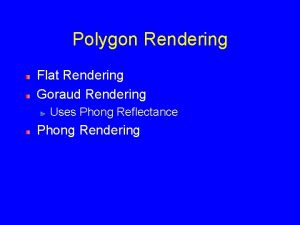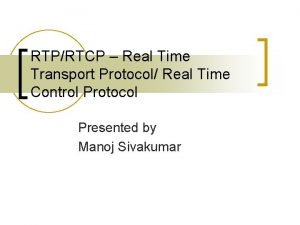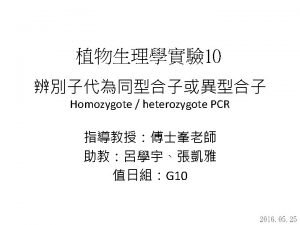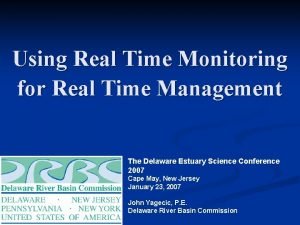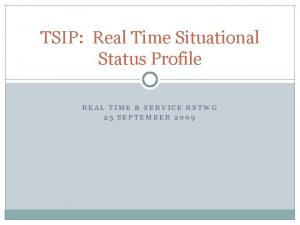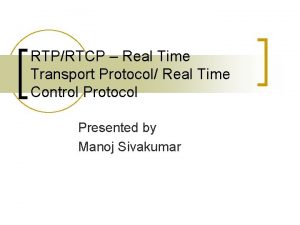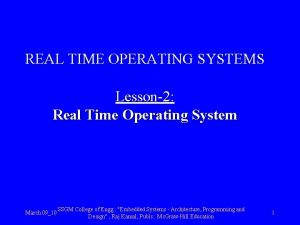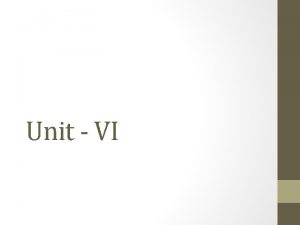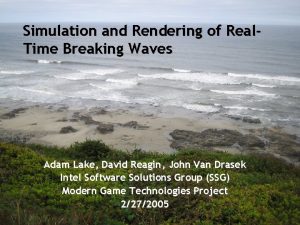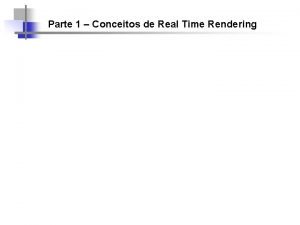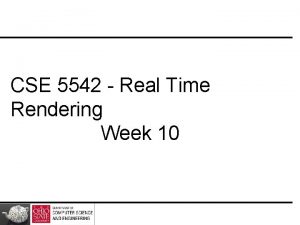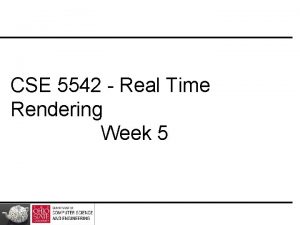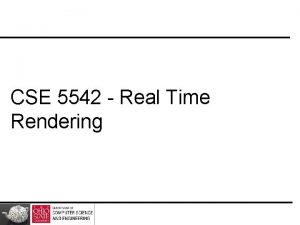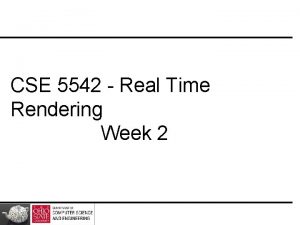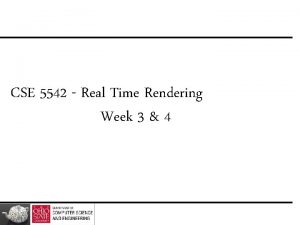Rendering Large Models in real time A large



















- Slides: 19

Rendering Large Models (in real time) • A large model may contain billions of polygons and take up gigabytes of memory • Such models arise naturally in: – Architectural walkthroughs – CAD (aircraft, ships, oil platforms…) – Training simulators and games • Generally, users wish to move about the model, looking around, and see in real-time a stream of images from the current viewpoint – Real-time means at least 10 frames-per-second, but 20 frames-per-second is much, much better

Tools for Large Models • Visibility Culling: Avoid touching data for parts of the model the viewer cannot see • Model Simplification (LOD): Reduce the complexity of the model with minimal impact on visual quality • Image-Based Representations: Replace geometry with images • Database Management: Ensure that data required for the current frame is in memory, even if the entire model won’t fit

Simplification Overview • Run-time impact of simplification: – Reduces the cost of transforming the model – Reduces memory bandwidth to graphics subsystem – Little effect on rasterization (same pixels touched) • Useful properties of simplification algorithm: – Automatic - models are too big to examine by hand – Few restrictions on input data (eg allow non-manifold meshes) – Major reduction in model complexity – Minimal increase in visual error – Fast – both preprocessing and run-time

Aspects of Simplification • Simplification operations: How are the geometry and surface properties modified? • Error Measures: How is error measured and controlled by the algorithm? • Are the simplified models static or dynamic? – Static: One of a few pre-computed models is chosen to be rendered – Dynamic: The simplification is done on the fly • Run-time Control: How is it decided which model to render?

Simplification Operations • Various basic operations are possible: – – – Vertex cluster Vertex remove Edge collapse Vertex pair Many minor variations • Each operation reduces the complexity by a small amount and influences a small region • Apply many operations in sequence to achieve large reductions

Vertex Cluster • Merge a set of vertices based on geometric proximity • Triangles may disappear, become lines or become points – Can choose to remove or render degeneracies • Very general, and doesn’t rely on manifold meshes • Can have a major impact on topology – Hard to make it look good

Vertex Remove • Remove a vertex and adjacent faces • Re-triangulate to fill hole – 2 fewer triangles – Exponential number of re-triangulations • Requires a manifold surface about the vertex • Preserves the local topological structure – Generally looks better

Edge Collapse • Merge two edge vertices into one, thus removing the edge – Choose position and attributes for the new vertex • Delete degenerate triangles – Reduction of 2 for manifold edge • The removal can be animated for a smooth transition – Move vertices toward new location, then delete them

Half-Edge Collapse • Collapse the edge to one of its endpoint vertices • Vertex sets remain a subset of the original set – property of vertex removal • Smooth transitions still possible – property of edge collapse

Vertex Remove vs. Edge Collapse Vertex Remove Half-Edge Collapse • Neighborhood: About 1 vertex vs. about 2 vertices • New vertices: None vs. one in free position • New tesselation: Many possible vs. one • Smooth transitions: Difficult vs. natural

Vertex Pair • Merge any two vertices – Choice based on geometry, topology, attributes, etc • More flexible than edge collapse – Can change topology quickly • More local control than vertex cluster – Choose vertices based on more than just proximity

Choosing an Operation • Attention to topology improves appearance • Supporting non-manifolds increases robustness and domain • Collapse-type operations support smooth transitions • Vertex removal affects a smaller portion of the mesh than edge collapse • A subset of vertex removal is equivalent to a subset of edge collapse

Simplification Algorithms • Rank the possible operations according to the error they will introduce – Must be able to measure error – Error metrics make all the difference • Repeatedly: – Do the operation that introduces the least error – Re-evaluate error in neighborhood of operation • Almost all good simplification algorithms fit into this framework – Note greedy approach does not in general ensure optimal result

Error Metrics • Always include a geometric component: – – Vertex-Vertex distance Vertex-Plane Distance Point-Surface Distance Surface-Surface Distance • May include attribute metrics – Aim to preserve pixel colors – Components for normal vectors, texture coordinates…

Vertex-Vertex Distance v 3 • E=max(||v 3 -v 1||, ||v 3 -v 2||) • Works during topological changes v 1 v 2 – Vertex clustering, Vertex pair – Rossignac and Borrel 93, Luebke and Erikson 97 • A loose metric for collapse type operations – Vertices don’t move very far, but surface deviation may be high

Vertex-Plane Distance a b c • Store a set of planes with each vertex – Error based on distance from the vertex to the planes – Merge the plane sets when vertices are merged – Tries to keep vertices near original surface • Ronfard and Rossignac 96 – Store planes, use max distance • Error Quadrics – Garland Heckbert 96 – Quadratic form instead of planes, use sum of square distances

Point-Surface Distance • Measure the distance from a set of points to the simplified surface – Point set representative of original surface – Use sum of squares distances • Hoppe 93 and 96 • Approximation to surface-surface distance • Expensive to compute

Surface-Surface Distance • Bounds the maximum distance between the input and simplified surfaces – – Tolerance volumes – Gueziec 96 Simplification Envelopes – Coehn/Varshey 96 Hausdorf Distance – Klein 96 Mapping Distance – Bajaj/Schikore 96, Cohen et. al. 97 • Arguably best measure

Error Metric Notes • A good metric allows you to transform error in object space into error in screen space – Simplifies decision of which model to display • Note that the metric are very different – Consider an edge-swap: – E=0 at verts and edges – E 0 everywhere else • Run-time metrics may take view into account
 Advances in real time rendering
Advances in real time rendering Real time rendering architecture
Real time rendering architecture Sensor and (tiempo real or real time)
Sensor and (tiempo real or real time) Difference between models and semi modals
Difference between models and semi modals Thorsten brants
Thorsten brants What is elapsed time
What is elapsed time Pencahayaan
Pencahayaan Hanspeter pfister
Hanspeter pfister Camera translate
Camera translate Masaki kawase
Masaki kawase Rendering pipeline in computer graphics
Rendering pipeline in computer graphics Volume rendering tutorial
Volume rendering tutorial Michael buehler
Michael buehler Reyes rendering
Reyes rendering Photorealistic rendering carlsbad
Photorealistic rendering carlsbad Clustered shading
Clustered shading Shadow rendering techniques
Shadow rendering techniques Splat rendering
Splat rendering Introduction to volume rendering
Introduction to volume rendering Car paint rendering
Car paint rendering

